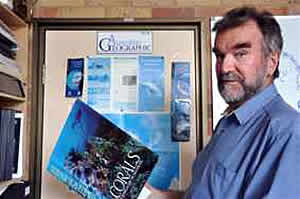
Associate Professor Graham Jones – one of the world’s leading marine scientists.
As ocean temperatures rise, the world's corals might stop producing natural cloud seeding chemicals and less rain will fall – potentially affecting the lush rainforests on Australia's east coast.
This is the dire prediction made by Associate Professor Graham Jones, a leading marine researcher with Southern Cross University's School of Environmental Science and Management.
The focus of Professor Jones' research over the past 20 years has been on how coral reefs and the oceans produce a natural gas called DMS (dimethyl sulphide) which creates clouds over the ocean.
He and his research team have found that algae living in coral tissue and in the ocean produce massive amounts of DMS. When it reaches the air, DMS forms cloud nuclei or 'cloud seeds' which help clouds form. The clouds both produce rain and reflect sunlight back into space, creating a cooler planet – phenomena with interesting implications for global warming.
A rise in ocean temperature of only two degrees Celsius above mean temperatures could cause some algae to stop producing DMS – potentially leading to less cloud formation and less rain.
"It is no coincidence that much of Australia's rainforest lies adjacent to the northernmost reefs," Professor Jones said. "Lower levels of DMS over coral reefs could dry out north Queensland's rainforests.
"We believe the clouds generated by the corals in the Great Barrier Reef are transported by the south-east trade winds from April to October and attract water vapor as they are transported to the rainforests of North Queensland.
"In the monsoonal or wet period, the north-east winds bring in clouds that are generated from reefs in the wider western Pacific to the north of us. When they reach the rainforests of North Queensland, these clouds produce rainfall.
"However, this mechanism needs to be further verified through government funding for the science that will substantiate this relationship."
Professor Jones said that in the 1970s, researchers from the Australian Bureau of Meteorology found very large concentrations of DMS in the air above the Great Barrier Reef. At that time, they guessed that the corals of the reef were responsible for the high count, but just how the mechanism worked was a complete mystery.
A lot more is now known about this mechanism and Professor Jones has been at the forefront of coral DMS research for over a decade.
The results of his team's coral reef DMS research will be presented at an international symposium on DMS at the National Institute of Oceanography in Goa, India, in October this year and at several national conferences in Brisbane and Cairns in June.
"Over the last 10 years, we have shown that corals contain the highest concentrations of these natural DMS aerosol particles on Earth and unlike phytoplankton in the ocean, they produce it continuously every day, because it is essential for their normal metabolism," Professor Jones said.
"One of the most fascinating aspects of the DMS story is that in order to form clouds, DMS must be emitted into the atmosphere and oxidized to form small sulphur aerosol particles, which attract water vapour. This is how stratocumulus clouds form over the ocean; and we believe this is how clouds form over coral reefs – which they commonly do.
"If the aerosol particles are not there, then, although there is lots of moisture, clouds will not form. We believe this process significantly affects the regional climate of North Queensland, where most of Australia's coral reefs occur.
"These small aerosol particles produce cloud droplets which lead to rainfall, if conditions are suitable. So the reef and the rainforest live in a type of symbiosis.
"A disturbing aspect of our recent research at Heron Island coral cay, however, has shown that when corals are stressed by elevated temperatures, coral bleaching occurs and the corals shut down production of atmospheric DMS.
"Unfortunately, because of global warming and pollution, much of the Great Barrier Reef is already stressed. If a significant portion of the reef dies, this local feedback mechanism will no longer function, and there will be a decline in DMS production."
Professor Jones said Southern Cross University research in the Antarctic had found that massive amounts of DMS is also emitted by algae each spring when the sea ice melts, again with important implications for cloud formation and climate over Antarctica.
He said research suggested that other forested and heavily vegetated areas of the globe might also produce a similar effect, in that it is likely that trees and plants themselves produce cloud-forming aerosol particles. But, as with the coral reefs, production of DMS can be shut down when the climate suffers stress.
"More funds are required to investigate this ground-breaking research that was started in Australia by our own Southern Cross University researchers," Professor Jones said.
